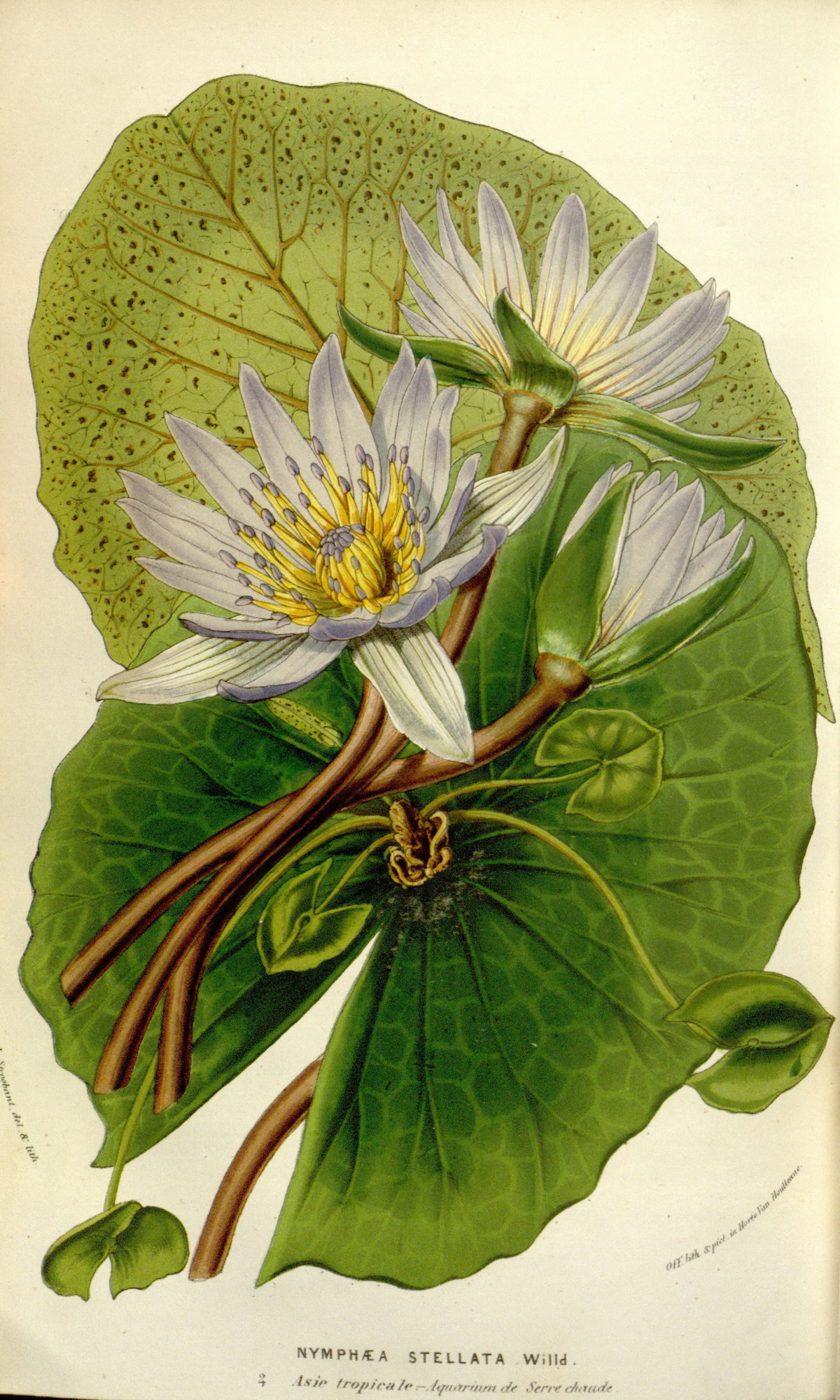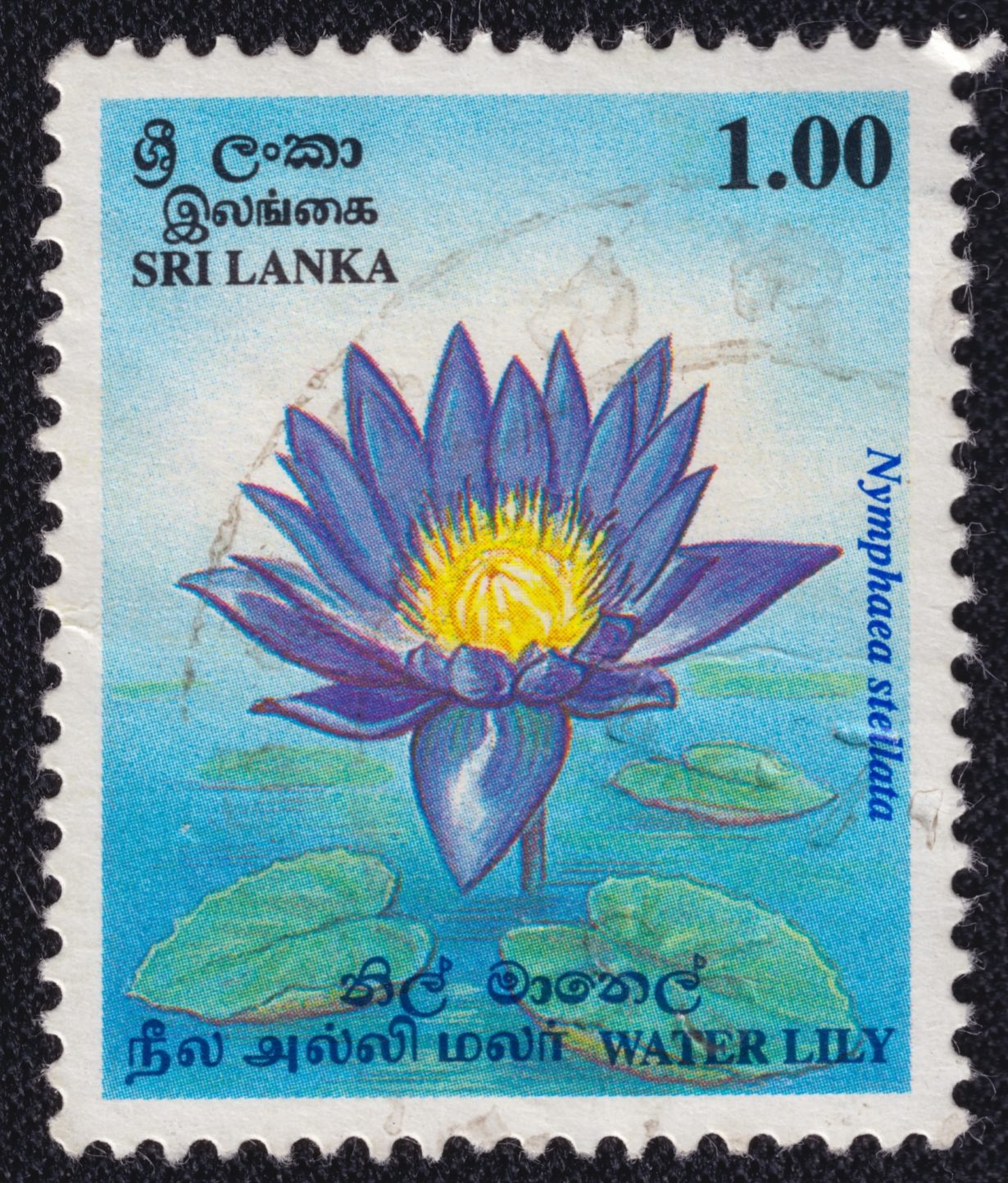To some, it’s a symbol of purity and enlightenment, and to others a reminder of exclusion, persecution and violence
The nil manel, or blue waterlily, is the national flower of Sri Lanka: a pale-blue bloom whose Latin names are Nymphaea stellata and Nymphaea nouchali. Its natural habitat is the many lagoons that dot this island-nation, where it grows together with numerous other nymphaeas, in a stunning array of colours: many are white, with bright yellow stamens; others, like the nil rubra, are a uniform deep pink, which colours the petals and the stamens alike. The nil pubescens has petals in a faint striated pink on the outside and seamless soft white on the inside. In Buddhist temples, a particularly striking electric-purple waterlily, called dam manel, is placed at the feet of sacred statues: its deep, bright shade is similar to that which can be produced by mixing ultramarine and magenta. It is made even more distinctive by the yellow-orange stamens in its centre. Because of its flamboyance, it has often been mistaken for the national nil manel, even appearing on stamps and official publications. Chatting informally with people in Colombo, or by one of Sri Lanka’s holiest Buddhist temples in Kandi, The Temple of the Tooth (it shelters an ancient tooth that is believed to have belonged to the Buddha), or at the Buddhist temples on the small islands off the Jaffna Peninsula, in Nainativu, where pilgrims go with their arms full of dam manels: no one has any doubt about this being the national flower. Arguing in favour of the pale nil manel always elicits surprised looks. After all, the dam manel cuts a much grander figure than its paler periwinkle cousin. To appreciate the charms of the nil manel requires an eye for detail: its peculiar stamens sport periwinkle tips, which dot its otherwise yellow stamens. What makes this flower truly significant, though, is its religious and political history, which cloaks it in a sombre aura of cruelty.
If choosing one form above so many others with respect to national symbols can seem to be an exercise in arbitrariness, such choices nevertheless boil down to a very precise politics. Flags sport colours claiming to represent national heroes’ blood, the pure whiteness of the country’s intentions and souls (but why is white still the symbol of purity? And why should purity deserve such praise?); the brightness of a nation’s future is shown in sunflower-yellow, green fields are unimaginatively rendered as green stripes; blue stands for ‘freedom’ even in the least free of countries and so on. The list of chromatic clichés is a long one. In the same manner, we might picture a panel of men (for such symbols have largely been made up by men) solemnly discussing whether a rose or a jasmine bud, a cherry blossom or a waterlily, is best able to convey national glory.

When the government in Colombo selected the nil manel as the national flower, it chose this periwinkle waterlily to engrave on the country a certain ethnic and religious exclusion. This dainty nymphaea is said to be one of the 108 auspicious symbols that blossomed from the Buddha’s footprint after his ascendance to nirvana, and it symbolises discipline, virtue, enlightenment and purity. Before marvelling – or despairing – at the insistence with which we apply anthropocentric values to the natural world, we would do well to remember that this devoutly inspired selection of the nil manel as Sri Lanka’s floral emblem took place in 1986, when the country’s civil war, which lasted from 1983 to 2009, was in one of its acute phases. The Tamil minority (mostly Hindu) found itself in the crossfire between the state violence of the Sinhala majority (mostly Buddhist) and the Liberation Tigers of Tamil Eelam (LTTE, mostly secular) – the last of which, through terror and armed struggle, was trying to establish a Tamil homeland in the Jaffna Peninsula and in the lands directly south from it. The LTTE’s brutality spared nobody – not the Sri Lankan army, Sinhalese civilians or the civilian Tamil population, which endured decades of violence: before the formal beginning of the war, Tamils had already experienced a number of pogroms, during which hundreds were killed, purely for being Tamil, and for adhering to the ‘wrong’ religion. Self-appointed Tamil defenders (before the establishment of the Tigers) had been carrying out terror attacks against state symbols and state representatives, resulting in hundreds of Tamil citizens becoming victims of collective punishments: mobs attacked Tamil businesses and people, with no reaction from those in positions of authority, who, on the contrary, ‘disappeared’ and jailed Tamils and those who criticised the government in the name of a ‘national emergency’.
The bloodiest riots took place in 1983, in what is now remembered as Black July, when Tamils were killed across the island (400–600 people in government figures, but likely thousands, perhaps as many as 5,000), marking the war’s beginning. The end of the war has an even more precise date: 18 May 2009. On that date, on a narrow strip of land nicknamed ‘The Cage’, which sits between the Bay of Bengal and the shallow Nandikadal lagoon (a two-hour drive from Jaffna), the Sri Lankan army decimated the remaining Tigers, after three years of encircling them in an increasingly small area. Velupillai Prabhakaran, the Tigers’ bloodthirsty commander, was among those killed – together with up to 70,000 civilians who, by government mandate, had been dragged into and trapped within the ‘No Fire Zone’ of The Cage in the final phase of the conflict, only to be shelled by government forces, in spite of all promises. (The number of unaccounted-for civilians is more than double that estimate.) In defence of their actions, the armed forces claimed, at times correctly, but often spuriously, that the Tigers were using civilians as human shields. The ‘safe zones’ turned out not to be safe at all, as the Sri Lankan Army didn’t treat them as such. Instead, they became the gravesites of tens of thousands of Tamils, who often died as they were queuing for food and medical supplies.

National War Heroes’ Day falls on 18 May, although many in the Jaffna Peninsula call it Remembrance Day: for those who disappeared, who were swallowed by the lagoon or by the sea, or who were buried in mass graves that are still being discovered to this day. Every year, hundreds of people make the painful pilgrimage to the coastal city of Mullaitivu, along the coast where the land and the sea weave into each other, creating large lagoons and small ponds where waterlilies grow, to remember the civilians killed by the army, or by the Tigers; and those simply listed as ‘missing’. Flowers are strewn on the sand. Prayers are offered. Candles are lit.
North of Mullaitivu, installed in a pond (depending on the time of year, this might become a small lake), is the Monument to Victory of Puthukkudiyiruppu: a golden statue of a helmeted soldier erected on a plinth set upon a mound of rocks. The statue can be reached via a wooden bridge above the pond’s waters. The soldier’s mouth is open in a silent scream. Both his arms are raised in the air: in one he brandishes a golden Type 56 assault rifle (favoured by the Sri Lankan military), onto which a spreadeagled golden dove is just landing (unless it’s just taking off); in the other he holds the colourful Sri Lankan flag. A metal panel at the entrance of the wooden path explains, in Sinhala, Tamil and English, that this is ‘The Golden Sun of the Peace of all the people, Rose wiping out the darkness of the North & East’. It calls the carnage that happened in this area the ‘Wanni Humanitarian Operation’ – and further details: ‘The pond symbolizes the great ocean around the island and national flower lilies which bloom in it symbolize our immaculate nation’. In spite of the national confusion between the nil manel (periwinkle) and the dam manel (purple), this pond carries only the national (and Buddhist) pale blue, ethereal nymphaeas: as if to signal to the Tamils, and to their religious faith, that they don’t entirely belong.
The innumerable calls for an investigation into the last months of the war, and the brutal toll that was inflicted on civilians, have never achieved anything. Tens of thousands were killed, and nothing happened. The lack of consequences there has created a terrifying precedent. In late May The Jerusalem Post reported the words of Moshe Elad, an Israeli security expert, claiming that the military defeat of the Tigers offered a ‘morally fraught’ model for eliminating Hamas – but a model nonetheless.
Far from the Sri Lankan Cage grows the red crown anemone, or Anemone coronaria: Israel’s national flower. Bright red, with a black centre, it is endemic to the Gaza/Israel border: the area where the terror attacks of October 7 took place, and where, just a few steps away, hundreds of Palestinians are dying every day, on a narrow strip of land that more and more resembles The Cage. It is said to represent hope. After a one-year hiatus to mourn those who were taken hostage on October 7, this year the annual Darom Adom Festival, held when the red anemones are in bloom, returned, even if with a scaled down programme, meant to honour the hostages. Meanwhile, Gaza is cut off from the world, and Palestinian civilians are being shelled and starved, on an even greater scale than what was inflicted on Tamil civilians in The Cage. The impunity, however, is the same.
Ilaria Maria Sala is a writer and journalist based in Hong Kong
